 |
eslas in beckenham
This was one of the first installations I documented, using with my rather rubbish original digital camera. These
pictures appeared on my first website along with the comments.
As far as I know, this installation is still there.
These pictures were taken on the 9th July 2000 at The Avenue in Beckenham, Kent.
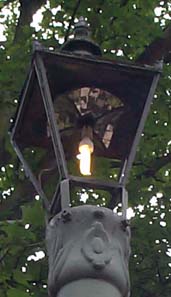
|
esla bi-multi group 'a' four-way #1
Left: A four-way ESLA mounted in an old square-top gas lantern, bolted to the top of a sewer
vent pipe.
The Avenue, Beckenham, South London is split into two halves. The section nearest the High Street is lit
with Thorn Gamma Six lanterns on 5M Concrete Utilities
Byway X columns. (The Gamma Sixes replaced post-top fluoroscent lanterns
in the late 1980s.) The vast majority of Beckenham's side streets are lit by these means.
The second half of The Avenue, which stretches up through the leafy suburbs towards Bromley, is a private road.
This has retained its original 1930s installation, and as buildings have been built on the hill
towards Bromley, incandescent lanterns have slowly been added. This slow addition to the installation
took place through the 1940s to the 1970s.
This private road represents an interesting walk through street lighting history. And I wouldn't
mind betting that the ESLA lanterns, with their individual mountings, are unique in the UK.
I'll start with the newest lamp posts and walk down the hill towards Beckenham, effectively walking backwards
through time.
|
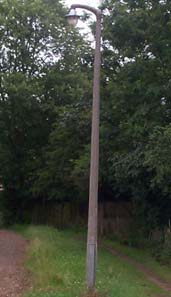
|
thorn beta 4
Left: This Thorn Beta Four is the first column approached as you walk along
the mud path or the gravel road. This incandescent example from Thorn's catalogue
never gained the popularity of GEC's Z 5580/5590 series and
is becoming quite rare. For lighting engineers to switch from GEC to
Thorn fittings within an installation is very rare, but many streets in Beckenham were being
relit with
Thorn Beta Five SOX lanterns in the early seventies, and they may have just
selected this incandescent from Thorn's catalogue for this road.
The concrete column, a Concrete Utilites Byway X, was the last concrete
column design produced by Concrete Utilites, and is still a common sight on many streets
(this column appeared in the mid 1970s and was still being installed in the late 1980s.) It's sleek lines
should be compared with the Birdcage column further down the road.
|
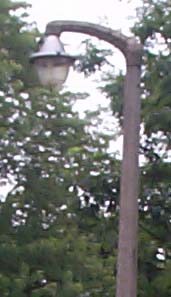
|
thorn beta 4: detail
Left: A close-up of the bracket and lantern. This Thorn Beta Four doesn't
include the optional refractor fitting, a grooved piece of plastic that fits into the top of the
bowl.
|
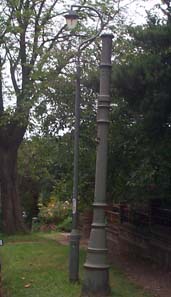
|
gec z5580
Left: At the brow of the hill, a lone GEC Z5590 stands on a
1970s-era swan neck and steel column.
Note the sewer vent pipe to the right of the column. This features a groove where an earlier street
light would have been slotted (an incomplete example remains in the neighbouring Foxglove Road).
But, more modern street lighting planning perfers the use of separate columns for the mounting of street lights.
|
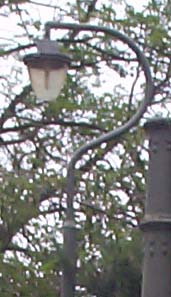
|
gec z5580: detail
I'd say this is a GEC Z5580 as the canopy's neck appears rather short (the only real difference between
this and the GEC Z5590).
The polycarbonate bowl was transparent when first installed, but has started to turn yellow with age.
|
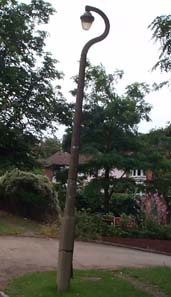
|
gec z5560
Left: We're now in the 1960s-1970s. Again, swan neck lighting is preferred, but the column is
a GEC concrete column. We now have an example of the
GEC Z 5560 with a wide necked canopy.
Note that the lock on the control gear compartment has failed and the cover is held on with black tape. (This
can be seen stretched around the base of the column.)
|
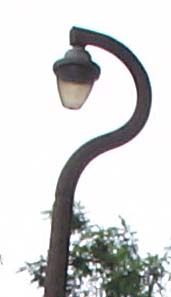
|
gec z5560: detail
Left: A close-up of the lantern and the swan neck. Spalling (the major cause of failure and
replacement of concrete columns) has started to occur where the swan neck joins the column. Apart from
this, the rest of the top assembly appears to be in good condition.
The yellowing of the polycarbonate bowl can be clearly seen here.
|
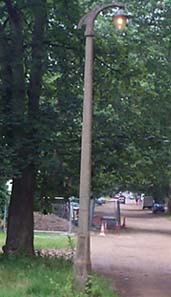
|
gec z5560
Left: We've now joined the 1950s-1960s and returned to a Concrete Utilities column.
A GEC Z 5560 is used, but it's mounted on a rare
Concrete Utilities Birdcage[1] lantern. Note the
general bulky appearance of the triangular base of the column, the decorative grooves, and the
elegance of the 'bishops crook' bracket.
[1] I believe this is the birdcage column and bracket.
|
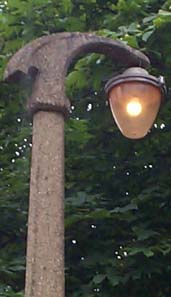
|
gec z5560: detail
Left: A close-up of the lantern. The time-switch for this lantern has clearly failed and
the incadescent lamp is left on permanently.
This is the simplest form of the GEC Z 5560. Some versions feature a glass
refractor enclosing the bulb.
Given the bracket's vintage, the concrete is in great condition. The earlier Concrete Utilities
brackets
seem to fare better than their modern successors. The thickness of the concrete could be one factor, but the
correct installation of the bracket on the column is another. If the column isn't capped correctly during
installation, water can creep in, and spalling starts. This was the problem with the vast majority
of concrete columns in the 1970s-1980s.
The other weak point is the bracket's termination with the lantern's mounting tube. Again, this column
still appears to be in mint condition.
|
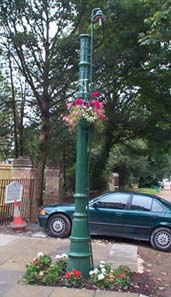
|
esla bi-multi group 'a' two-way #1
Left: As mentioned previously, the first installation of street lights in Beckenham
utilised the sewer vent pipes. Here's possibly one of the last surviving examples. A tiny ESLA
two-way mirror fitting is strapped to the vent, with a control box bolted to the side.
This vent stands in front of a new building site, and has recently been repainted green (Beckenham's
original street lighting colours) and flowers have been added in hanging baskets. It's obviously
being looked after.
The spindly iron tubing that carries the wiring and holds the lantern looks very DIY by today's
modern standards.
|
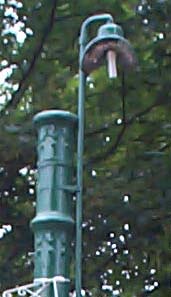
|
esla bi-multi group 'a' two-way #2
Left: A closeup which reveals two interesting characteristics of this lantern.
Firstly, the neck of the ESLA isn't the normal, long tappered neck of the much
larger ESLA
lanterns in my collection. Instead, it features a shorter and wider neck. I believe this is cast aluminium
making this a more modern ESLA than the
Cheam installation or the examples in my
collection.
Note the tape used to hold the tube to the side of the vent - not original! But painted green anyway.
|
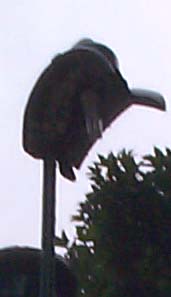
|
esla bi-multi group 'a' two-way #3
Left: An attempt to capture the glass pattern, but it's too dark to see. There are three
columns of glass rhombuses on either 'wing'. The right side is starting to rust away at it's base. It's
a tiny lantern - probably the smallest ESLA I've ever seen.
|
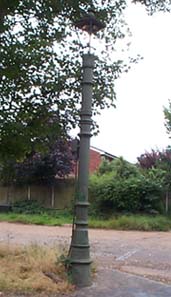
|
esla bi-multi group 'a' four-way #2
Left: This sewer vent pipe stands at the the crossroads at the bottom of the hill, which
marks the start of the private section of the road. An old
square gas lantern is bolted over the top of the vent, and is fitted with a four way ESLA
fitting.
|

|
esla bi-multi group 'a' four-way #3
Left: A great view of a four-way ESLA fitting. Each 'wing' is angled
parallel to the road at this crossing.
It isn't known if ESLA supplied 'traditional' square gas lanterns fitted with ESLA
lanterns. This example is also missing all its glass - but it isn't known if glass was originally included.
There's also
an interesting modification to the spider, consisting of vertical bars bolted to the top of the vent.
The copper tube used to focus the bulb fell out of the lantern in the mid 1990s. As can be seen now, the
wire holding the bulb fitting simply hangs outside the lantern.
All-in-all this is a fascinating and unique installation.
|
|



